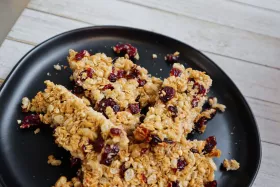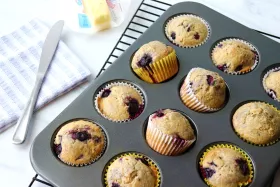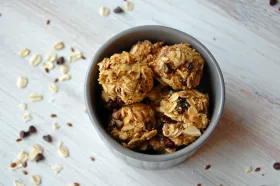Here are several recipes to get you started. See the Now You’re Cookin! series at NDSU Extension for meal planning and preparation tips and recipes. See Pinchin’ Pennie$ for ways to use what is already in your pantry to make soups, casseroles, stir-fry and much more. See Field to Fork (www.ag.ndsu.edu/food) for many healthful recipes and ways to incorporate more fruits and vegetables into your meals.
Rosemary Pecan Chicken Salad Sandwiches
Sandwich filling ingredients
1-pound boneless, skinless chicken breast, cooked, cooled and diced
1¼ cups apples, chopped
⅓ cup pecans, chopped
⅓ cup dried cranberries
Dressing ingredients
1 (5.3-ounce) container fat-free plain Greek yogurt
2 tablespoons mayonnaise
1 tablespoon red wine vinegar
2½ teaspoons fresh rosemary, finely chopped
1 teaspoon Dijon mustard
½ teaspoon honey
½ teaspoon onion powder
Salt and fresh ground black pepper (to taste)
Combine cooked chicken, apples, pecans and cranberries in a large mixing bowl. In a separate, small mixing bowl, stir together dressing ingredients. Season with salt and pepper. Pour dressing over chicken mixture and toss to coat evenly. Serve on whole grain bread with lettuce.
Makes 4 servings. Each serving has 310 calories, 15 grams (g) fat, 28 g protein, 18 g carbohydrate, 2 g fiber and 125 milligrams sodium.
Side item suggestions: Cold pasta salad, broccoli and cauliflower florets, baby carrots and/or celery sticks, baked potato chips or corn chips, apples or pears.
Pulled Pork Sandwiches
1 small pork tenderloin (2 to 3 pounds)
1 packet dry onion soup mix
¾ cup water
Wheat buns and assorted toppings
Cut thawed tenderloin into three or more chunks. Add all ingredients in the slow cooker. Turn slow cooker on high for six hours. Pull apart meat with a fork after four to five hours. This recipe is good on a wheat bun or wrap with barbeque sauce, tomato slices, zucchini slices or cucumber slices.
Makes 8 servings. Each serving has 150 calories, 4.5 grams (g) fat, 24 g protein, 2 g carbohydrate, 0 g fiber, and 210 milligrams sodium.
Side item suggestions: Salad (coleslaw, potato salad, or cold pasta salad with vegetables), baked chips or corn chips, green and red grapes.
Create Your Own Tortilla Wraps
Wrap ideas:
- Turkey with cheddar jack cheese, hummus, tomatoes and spring mix lettuce
- Ham with Swiss cheese, mustard, tomatoes and spinach
- Taco inspired — taco meat, pico de gallo, cheese, leafy greens, guacamole
- Pesto, artichokes, tomatoes and mozzarella cheese
- Strawberries, peanut butter and apples
- Banana, peanut butter, jelly
1 low-sodium tortilla
2 slices deli meat
1 tablespoon spread
¼ cup leafy greens
1 slice cheese
¼ cup vegetables, sliced
Slice tortilla from center to one edge. Add each ingredient to a separate quadrant. Starting with the section to the right of the cut line, fold over onto the adjacent section. Repeat until all are folded. Wrap in plastic wrap then foil for an easy “grab and go” meal/snack.
Makes 1 serving. 1 serving has 220 calories, 10 grams (g) fat, 21 g protein, 20 g carbohydrate, 1 g fiber and 480 milligrams sodium.
Side item suggestions: Baby carrots and broccoli florets with ranch dip, whole-grain tortilla chips, mixed fruit cup (pineapple, peaches).
Beef and Bean Burritos
½ pound ground beef
2 (15 to 16 oz.) cans kidney, pinto or red beans
1 onion, chopped
1 tablespoon chili powder or 1 package taco seasoning
8 large flour tortillas
Salsa of choice
Chop onion. Brown ground beef and onion in a frying pan. Drain fat. Mix in kidney beans and chili powder. Put a spoonful of meat mixture in the center of the tortilla. Fold opposite edges of the tortilla over the meat. Then fold both ends to the center to form a pocket. Set burrito in baking dish. Heat burritos in a covered dish for 10 to 15 minutes at 350 F. Serve with salsa. Wrap in plastic wrap then foil for an easy grab and go meal/snack.
Makes 8 servings. Each serving has 400 calories, 8 grams (g) fat, 21 g protein, 61 g carbohydrate, 7 g fiber and 790 milligrams sodium.
Side item suggestions: Whole-grain tortilla chips, corn and black bean salsa, watermelon chunks.
One-pan Chicken Fajitas
1½ pounds chicken breasts cut into ½-inch strips
2 red bell peppers, sliced into strips
1 green bell pepper, sliced into strips
1 onion, sliced
3 tablespoons olive or canola oil
1 packet taco seasoning, reduced sodium
1 lime
10 whole-wheat tortillas
Optional toppings: shredded cheese, salsa, sour cream, avocado slices
Preheat oven to 425 F. Sprinkle taco seasoning and drizzle olive oil into bowl with chicken, bell peppers and onion. Toss to coat. Spread contents on greased sheet pan; bake 20 to 25 minutes or until chicken is fully cooked. Squeeze lime juice over pan and serve with whole-wheat tortillas. Wrap in plastic wrap then foil for an easy grab and go meal/snack.
Makes 10 servings (one fajita per serving). Without added toppings, each fajita has 280 calories, 9 grams (g) fat, 20 g protein, 27 g carbohydrate, 3 g fiber and 380 milligrams sodium.
Side item suggestions: Refried beans or black beans, Spanish rice, strawberries and yogurt.
Cranberry Granola Bars
½ cup honey
2 tablespoons + 2 teaspoons brown sugar, packed
1 tablespoon + 1 teaspoon vegetable oil (soybean oil)
1½ cups oatmeal oats, quick (uncooked)
1¼ cups toasted rice cereal
1¼ cups dried cranberries
Preheat oven to 350 F. Combine honey, brown sugar and oil in a small saucepan. Heat over low heat until well mixed. Mix oats, rice cereal and cranberries. Add honey mixture and stir until thoroughly combined. Pat firmly into an 8-by-8-inch baking pan. Bake for 15 minutes; press firmly into the bottom of the pan once more. Bake for five more minutes. Cool completely. Refrigerate at least one hour for easier cutting. For easy serving, wrap each piece in plastic wrap.
Makes 16 servings. Each serving has 120 calories, 2 grams (g) fat, 1 g protein, 25 g carbohydrate, 1 g fiber and 15 milligrams sodium.
Side item suggestions (snack): Cheddar cheese cubes, apple or pear.
Better Than Basic Muffins
Muffin ideas:
- Fruit - apples, blueberries, blackberries, peaches, pears, raspberries, strawberries
- Dried Fruit - blueberries, cranberries, coconut, cherries, strawberries
- Nuts - sliced almonds, macadamia nuts, pecans, pistachios, walnuts
- Sweets - chocolate chips, butterscotch chips, white chocolate chips, cinnamon chips
- Flavor extracts - almond, lemon, lime or vanilla
2 cups all-purpose flour
1 cup whole wheat flour
1 cup sugar
1 tablespoon baking powder
½ teaspoon salt
½ cup (1 stick) unsalted butter, softened (not melted)
2 eggs
1 cup milk
2 teaspoons flavor extract (or as desired)
Up to 2 cups of mix-ins (fruit, nuts, vegetables, baking chips)
Preheat oven to 400 F. In a large bowl, whisk together the flour, sugar, baking powder and salt. Cut in the butter with a fork or pastry cutter. Stir in the eggs, milk and flavor extract until all ingredients are incorporated. Stir in desired mix-ins, but do not over mix. Evenly divide the batter between the prepared muffin cups. Bake for 15 to 20 minutes or until a toothpick inserted in the center comes out clean.
Makes 24 servings. Each muffin has 130 calories, 4.5 grams (g) fat, 3 g protein, 21 g carbohydrate, 1 g fiber and 250 milligrams sodium.
Side item suggestions (snack): Hard-cooked egg, mozzarella stick, orange slices.
Energy Bites
1 cup oats
½ cup nut butter
¼ cup honey or maple syrup
¼ cup dried fruit
¼ cup nuts
2 tablespoons flaxseed
2 tablespoons chocolate chips
Combine all ingredients in a bowl and stir to combine. Chill for 30 minutes to firm up. Roll into tablespoon-size bites. For easy serving, place portions in small plastic snack bags.
Makes 24 Servings. Each serving has 75 calories, 3.5 grams (g) fat, 2 g protein, 9 g carbohydrate, 1 g fiber and 35 milligrams sodium.
Side item suggestions (snack): Yogurt with fruit.
Funding for this project was made possible by the U.S. Department of Agriculture’s Agricultural Marketing Service through grant 21SCBPND1069. Its contents are solely the responsibility of the authors and do not necessarily represent the official views of the USDA.
NDSU Extension does not endorse commercial products or companies even though reference may be made to tradenames, trademarks or service names.
For more information on this and other topics,
see www.ag.ndsu.edu/food
County commissions, North Dakota State University and U.S. Department of Agriculture cooperating. NDSU does not discriminate in its programs and activities on the basis of age, color, gender expression/identity, genetic information, marital status, national origin, participation in lawful off-campus activity, physical or mental disability, pregnancy, public assistance status, race, religion, sex, sexual orientation, spousal relationship to current employee, or veteran status, as applicable. Direct inquiries to Vice Provost for Title IX/ADA Coordinator, Old Main 201, NDSU Main Campus, 701-231-7708, ndsu.eoaa@ndsu.edu. This publication will be made available in alternative formats for people with disabilities upon request, 701-231-7881. 3.5M-8-23

 Allergens/Food Sensitivities/Dietary Restrictions
Allergens/Food Sensitivities/Dietary Restrictions








